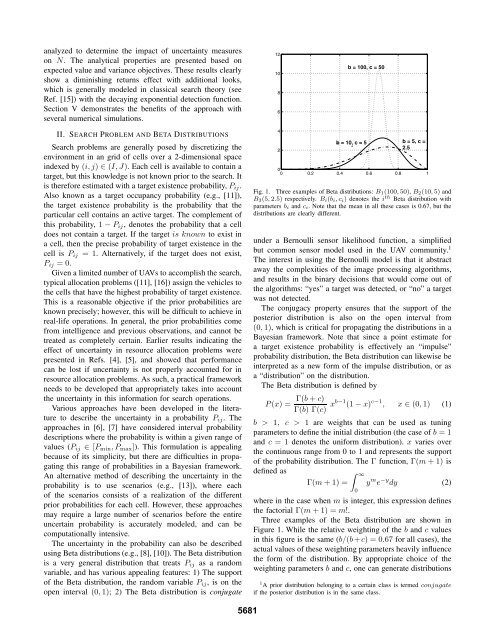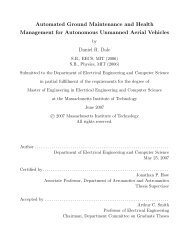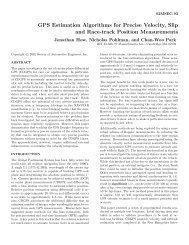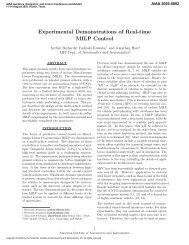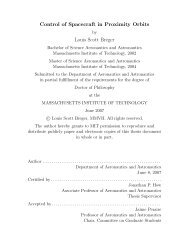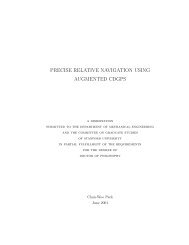Robust UAV Search for Environments with Imprecise Probability Maps
Robust UAV Search for Environments with Imprecise Probability Maps
Robust UAV Search for Environments with Imprecise Probability Maps
You also want an ePaper? Increase the reach of your titles
YUMPU automatically turns print PDFs into web optimized ePapers that Google loves.
analyzed to determine the impact of uncertainty measures<br />
on N. The analytical properties are presented based on<br />
expected value and variance objectives. These results clearly<br />
show a diminishing returns effect <strong>with</strong> additional looks,<br />
which is generally modeled in classical search theory (see<br />
Ref. [15]) <strong>with</strong> the decaying exponential detection function.<br />
Section V demonstrates the benefits of the approach <strong>with</strong><br />
several numerical simulations.<br />
12<br />
10<br />
8<br />
6<br />
b = 100, c = 50<br />
II. SEARCH PROBLEM AND BETA DISTRIBUTIONS<br />
<strong>Search</strong> problems are generally posed by discretizing the<br />
environment in an grid of cells over a 2-dimensional space<br />
indexed by (i, j) ∈ (I,J). Each cell is available to contain a<br />
target, but this knowledge is not known prior to the search. It<br />
is there<strong>for</strong>e estimated <strong>with</strong> a target existence probability, P ij .<br />
Also known as a target occupancy probability (e.g., [11]),<br />
the target existence probability is the probability that the<br />
particular cell contains an active target. The complement of<br />
this probability, 1 − P ij , denotes the probability that a cell<br />
does not contain a target. If the target is known to exist in<br />
a cell, then the precise probability of target existence in the<br />
cell is P ij =1. Alternatively, if the target does not exist,<br />
P ij =0.<br />
Given a limited number of <strong>UAV</strong>s to accomplish the search,<br />
typical allocation problems ([11], [16]) assign the vehicles to<br />
the cells that have the highest probability of target existence.<br />
This is a reasonable objective if the prior probabilities are<br />
known precisely; however, this will be difficult to achieve in<br />
real-life operations. In general, the prior probabilities come<br />
from intelligence and previous observations, and cannot be<br />
treated as completely certain. Earlier results indicating the<br />
effect of uncertainty in resource allocation problems were<br />
presented in Refs. [4], [5], and showed that per<strong>for</strong>mance<br />
can be lost if uncertainty is not properly accounted <strong>for</strong> in<br />
resource allocation problems. As such, a practical framework<br />
needs to be developed that appropriately takes into account<br />
the uncertainty in this in<strong>for</strong>mation <strong>for</strong> search operations.<br />
Various approaches have been developed in the literature<br />
to describe the uncertainty in a probability P ij .The<br />
approaches in [6], [7] have considered interval probability<br />
descriptions where the probability is <strong>with</strong>in a given range of<br />
values (P ij ∈ [P min ,P max ]). This <strong>for</strong>mulation is appealing<br />
because of its simplicity, but there are difficulties in propagating<br />
this range of probabilities in a Bayesian framework.<br />
An alternative method of describing the uncertainty in the<br />
probability is to use scenarios (e.g., [13]), where each<br />
of the scenarios consists of a realization of the different<br />
prior probabilities <strong>for</strong> each cell. However, these approaches<br />
may require a large number of scenarios be<strong>for</strong>e the entire<br />
uncertain probability is accurately modeled, and can be<br />
computationally intensive.<br />
The uncertainty in the probability can also be described<br />
using Beta distributions (e.g., [8], [10]). The Beta distribution<br />
is a very general distribution that treats P ij as a random<br />
variable, and has various appealing features: 1) The support<br />
of the Beta distribution, the random variable P ij ,isonthe<br />
open interval (0, 1); 2) The Beta distribution is conjugate<br />
4<br />
2<br />
b = 10, c = 5 b = 5, c =<br />
2.5<br />
0<br />
0 0.2 0.4 0.6 0.8 1<br />
Fig. 1. Three examples of Beta distributions: B 1 (100, 50), B 2 (10, 5) and<br />
B 3 (5, 2.5) respectively. B i (b i ,c i ) denotes the i th Beta distribution <strong>with</strong><br />
parameters b i and c i . Note that the mean in all these cases is 0.67, but the<br />
distributions are clearly different.<br />
under a Bernoulli sensor likelihood function, a simplified<br />
but common sensor model used in the <strong>UAV</strong> community. 1<br />
The interest in using the Bernoulli model is that it abstract<br />
away the complexities of the image processing algorithms,<br />
and results in the binary decisions that would come out of<br />
the algorithms: “yes” a target was detected, or “no” a target<br />
was not detected.<br />
The conjugacy property ensures that the support of the<br />
posterior distribution is also on the open interval from<br />
(0, 1), which is critical <strong>for</strong> propagating the distributions in a<br />
Bayesian framework. Note that since a point estimate <strong>for</strong><br />
a target existence probability is effectively an “impulse”<br />
probability distribution, the Beta distribution can likewise be<br />
interpreted as a new <strong>for</strong>m of the impulse distribution, or as<br />
a “distribution” on the distribution.<br />
The Beta distribution is defined by<br />
Γ(b + c)<br />
P (x) =<br />
Γ(b) Γ(c) xb−1 (1 − x) c−1 , x ∈ (0, 1) (1)<br />
b > 1, c > 1 are weights that can be used as tuning<br />
parameters to define the initial distribution (the case of b =1<br />
and c =1denotes the uni<strong>for</strong>m distribution). x varies over<br />
the continuous range from 0 to 1 and represents the support<br />
of the probability distribution. The Γ function, Γ(m +1) is<br />
defined as<br />
∫ ∞<br />
Γ(m +1)= y m e −y dy (2)<br />
where in the case when m is integer, this expression defines<br />
the factorial Γ(m +1)=m!.<br />
Three examples of the Beta distribution are shown in<br />
Figure 1. While the relative weighting of the b and c values<br />
in this figure is the same (b/(b + c) =0.67 <strong>for</strong> all cases), the<br />
actual values of these weighting parameters heavily influence<br />
the <strong>for</strong>m of the distribution. By appropriate choice of the<br />
weighting parameters b and c, one can generate distributions<br />
1 A prior distribution belonging to a certain class is termed conjugate<br />
if the posterior distribution is in the same class.<br />
0<br />
5681


